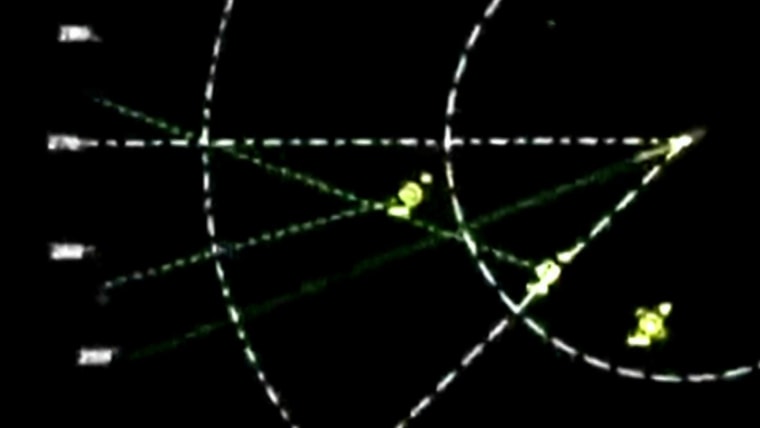A lot has been made of an unusual provision in a pandemic relief bill passed last year that required government agencies to provide an analysis of “unidentified aerial phenomena,” or, in layman’s terms, UFOs. The ensuing report out Friday, however, rains on the parade of those who hoped the military would determine there was alien activity on Earth: It found no evidence that UFOs are alien in origin.
It would be odd if the report said the government could rule out an extraterrestrial origin of UFOs while still knowing next to nothing about what they are.
People who think we have footage of spaceships flown by little green men (or little gray men or, according to the “Men in Black” films, a pug) are unlikely to be swayed by this. True believers may in fact counter that the report couldn’t prove that UFOs aren’t from outer space, which is indeed correct: The report didn’t state that the UFOs were not from outer space (the report didn’t even mention the word alien). But a failure to eliminate a hypothesis is not evidence for a hypothesis.
Based on the information currently available to my remotely located editor, it’s not possible for her to eliminate the hypothesis that this article was actually typed by a hedgehog that got extremely lucky when walking on a keyboard. But that is not evidence that “Adam Larson” is just a pseudonym for an eccentric insectivore, nor does it make the belief that I am a hedgehog reasonable. (For the record, I am not a hedgehog.)
Likewise, while the intelligence report didn’t eliminate the hypothesis that UFOs are extraterrestrial in origin, it is also likely unable to eliminate the hypotheses that UFOs are dragons or flying pigs or the Norse god Odin riding Sleipnir, his magical eight-legged horse. Unidentified flying objects are just that – airborne objects that we can’t identify.
In fact, it would be odd if the report said the government could rule out an extraterrestrial origin of UFOs while still knowing next to nothing about what they are, just like it would be strange for a report on an unidentified serial killer to determine that the killer is not from Tulsa even though nothing else of their origins is known.
These sightings also lack any good supporting evidence to suggest that they are life from other planets: UFOs were not observed entering our atmosphere from millions of miles away, leaving our atmosphere while en route to another planet or showing any sign of life, all things that would happen if UFOs really were extraterrestrials visiting us from Alpha Centauri.
Of course, those who believe that “the truth is out there” might point to the fact that the government report exists at all. But government interest doesn’t inherently mean something is real. When national security is on the line, there’s little that government agencies (domestic and foreign) haven’t investigated. We’re familiar with the crazy ideas that were successful (try wrapping your head around how nuclear weapons work), but there are many other projects that proved to be boondoggles.
During World War II, a dentist proposed what he thought would be a revolutionary new weapon: bat bombs. The military could strap incendiary bombs to hundreds of bats, which would then be dropped over the Japanese countryside where they would roost in buildings that the bombs would set ablaze. Project X-Ray, as it was called, was canceled after researchers had spent $2 million dollars but only succeeded in destroying an Air Force hanger and a general’s car.
Around the same time the bat bomb project was canceled, the military was paying psychologist B.F. Skinner to create pigeon-guided missiles. The idea was that three pigeon pilots inside a missile would peck at the controls to steer the rocket; like the bat bombs, they never saw a battlefield.
The Japanese Empire, not to be outdone in the field of bizarre bombings, attached bombs to thousands of balloons and used easterly air streams to send them from Japan to the continental United States (and Alaska and Mexico and Hawaii and everywhere in between). Aiming a balloon at a target thousands of miles away works about as well as you’d expect, though they did manage to kill six American civilians in Oregon with one of the thousands of balloons released.
The Cold War saw research projects grounded more in cheesy pulp novels than reality. The CIA was so worried about the possibility that the Soviets had invented mind control techniques that they tried to develop their own. Collaborating with scientists from Imperial Japan and Nazi Germany, they gave unwitting volunteers LSD (a serious violation of research ethics). They failed to develop mind control, but they did introduce Ken Kesey (author of “One Flew Over the Cuckoo’s Nest”) and many other countercultural luminaries to dropping acid.
Later, a loosely organized group of military researchers, worried about the possibility the Soviets had recruited psychics (see a pattern here?), tried to recruit psychics of their own in an attempt to spy on enemy military bases, predict new types of enemy weapons and kill goats just by touching them. They supposedly killed at least one goat, and definitively inspired a book with a movie adaptation that starred George Clooney: “The Men Who Stare at Goats.”
This isn’t to say that we shouldn’t fund odd sounding research (in fact, it’s vital that we do), but merely to say that government funding does not by itself prove that an idea is reasonable. (For a nonmilitary example, remember the bridge to nowhere?)
Ultimately, UFOs should be investigated not because we might need to call in Will Smith to fight aliens but because other, more plausible, explanations (like that UFOs are experimental technology from rivals overseas) are of national security importance.
Science relies on repeated observations to learn about the world, and right now, our observations of these unidentified aerial phenomena are limited. Part of science is admitting what we don’t know today — but to keep watching closely so we might know tomorrow.
Source: | This article originally belongs to Nbcnews.com










